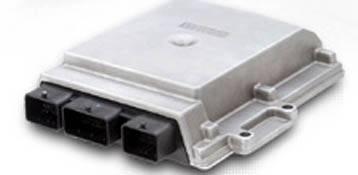
Although cars and trucks are usually thought of as only mechanical devices, they also have many different electronic parts that resemble a personal computer more than a vehicle. Almost every vehicle built from the early 1990's onward contains a small component called a powertrain control module (PCM) that electronically controls parts and runs diagnostic tests.
A powertrain control module is a printed circuit board computer housed in a heavy duty case that can withstand the extremes of temperatures normally experienced inside a vehicle's engine. The module constantly sends electronic signals to all of the different components in the engine, and tests the temperature and airflow around them, to check on the status of their operation. When a component is not working properly, the module turns on the "check engine light" on your vehicle's dashboard.
The control module examines the camshaft, coolant levels, crankshaft, ignition and valve timing, air intake and the turbocharger components in a car. It automatically regulates the ratio of air to fuel used in the engine and controls the idle speed so that the vehicle operates at peak performance levels. The module also works in conjunction with the catalytic converter to reduce the amount of pollutants expelled with the engine's exhaust and maintains the speed of the vehicle when the "cruise control" feature is turned on.
All powertrain control modules generate a specific diagnostic code based on the vehicle component that isn't working that can then be read by an electronic diagnostic tool used by mechanics. Reading the code makes diagnosing a vehicle's problem much easier than trial and error replacement of parts. As an extra benefit some modules can be re-programmed when new components are added to maximize efficiency or give performance increases.
Different makes and models of cars produced in different years may have separate kinds of connectors to plug into a diagnostic reading tool, although the connectors are almost always found in the same spot below the dashboard on the driver's side. Each model of powertrain control module will also have a different amount of memory to store previous diagnostic codes before old ones are erased to make room for new ones.
In cold temperatures, the powertrain control module executes a predetermined set of basic instructions until the engine raises to its normal temperature range, at which point the module then switches back to normal operation. The module also cannot work when the battery is disconnected and all codes will be deleted from its memory if the battery remains disconnected for more than 10 minutes. A module does not have a code to indicate when it is experiencing a problem, so the best indicator of a module failure is if it begins to produce codes for components that aren't malfunctioning.